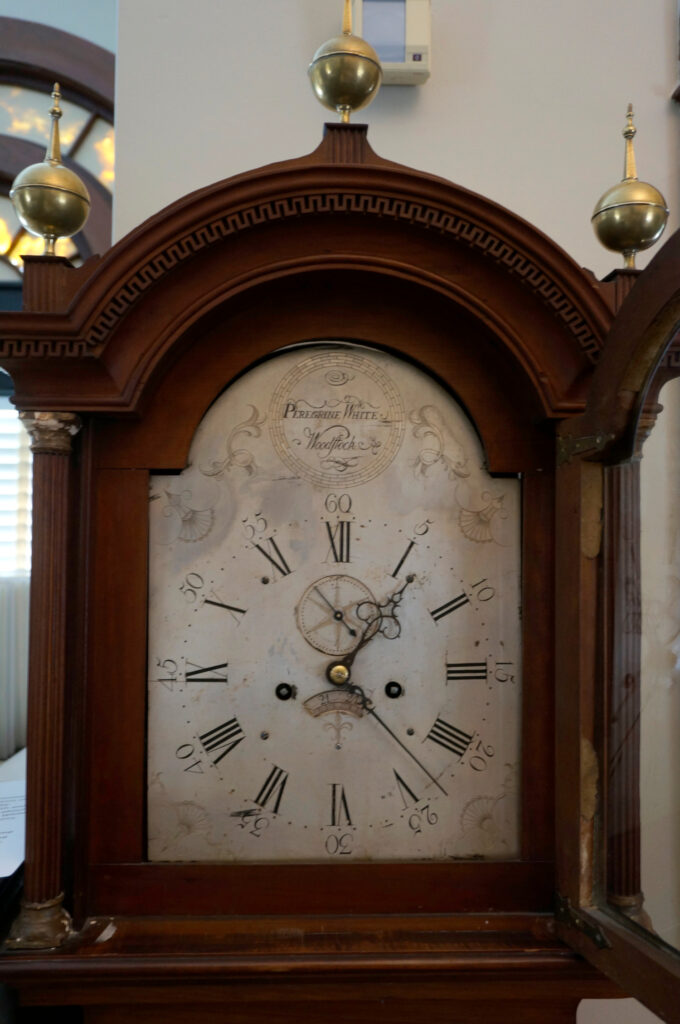May 2, 2023
The c. 1780 Peregrine White clock – also known as the Morse clock – is running again, keeping good time, chiming on the hour, and even telling the date! It stands right beside the society’s front entrance. Peregrine White (1747-1834) of Woodstock Connecticut was a prominent silversmith and clockmaker. He was a descendant of Peregrine White (1620 – 1704), the first English child born to pilgrims in America.

Eliakim Morse (1712-1803) built his house at 339 Main Street in 1750 and was the original owner of this clock. The clock remained in the house for several generations. We believe his great granddaughter, Mary B. Morse, who inherited the clock, was the last Morse to own it before it was given to the historical society.
In 2017 the Morse clock was cleaned and repaired by the late Bill Gruhn, 88, of Medfield, who gave a one-year warranty on his work. Two years later, Bill moved to the Cape. Then the clock was overwound and stopped working.
But Nick Werthessen has fixed it again – thank you, Nick!
At the same time, in 2017, Bill also cleaned and tuned up two other clocks which are estimated to be about 100 years old: the high-quality 30-day Seth Thomas clock that hung on the wall in the selectmen’s meeting room until the town hall renovations of 1998, and an inexpensive Gilbert schoolhouse clock.
Upon returning them, Bill noted that you should not move the hands backwards to adjust the time; doing so will damage the mechanism on some clocks; why take the chance on this one? If the clock is fast, better to stop the clock (open the case and reach in and stop the pendulum), adjust the speed, and wait and restart by swinging the pendulum when the time is right – or set the clock by moving the hands forward. Lift the face panel, and you’ll find the winding keys inside the clock.
For old mechanical devices, these clocks keep pretty good time. The slow-fast adjustment is via a knurled knob (that sounds like the beginning of a knock-knock joke) on the bottom of the pendulum. To speed up a clock that runs slow, turn the knob to raise the pendulum slightly. To slow it down, lower the pendulum by turning the knob. It takes several tries to get things right.
—
The Seth Thomas Clock Company was one of the most prolific and long-lived manufacturers of good quality clocks.
Seth Thomas was born in Wolcott, Connecticut in 1785, went to work for clockmaker Eli Terry in 1807, bought out Terry’s factory (together with Silas Hoadley) in 1810, and in December 1813 bought out Heman Clark’s clockmaking business in Plymouth Hollow. He continued making clocks until his death in 1859, when his sons and their heirs took over the business and made many innovations. A flood in 1955 severely damaged the factory; a series of sales and reorganizations followed; operations ceased in 2001.
There’s more on Seth Thomas here.
William L. Gilbert set up a factory in Winchester, Connecticut in 1840 to make inexpensive mass-market clocks. The company prospered and eventually employed over 500 people in four large buildings. It remained in business until 1964. The NRHP-listed buildings are now known as the Gilbert Clock Apartments.